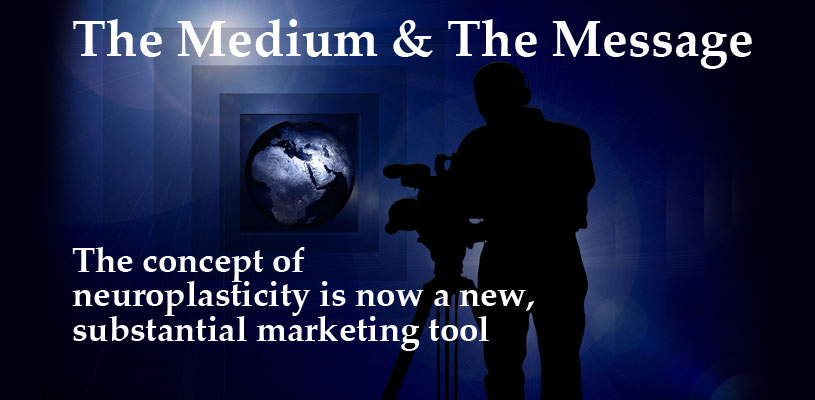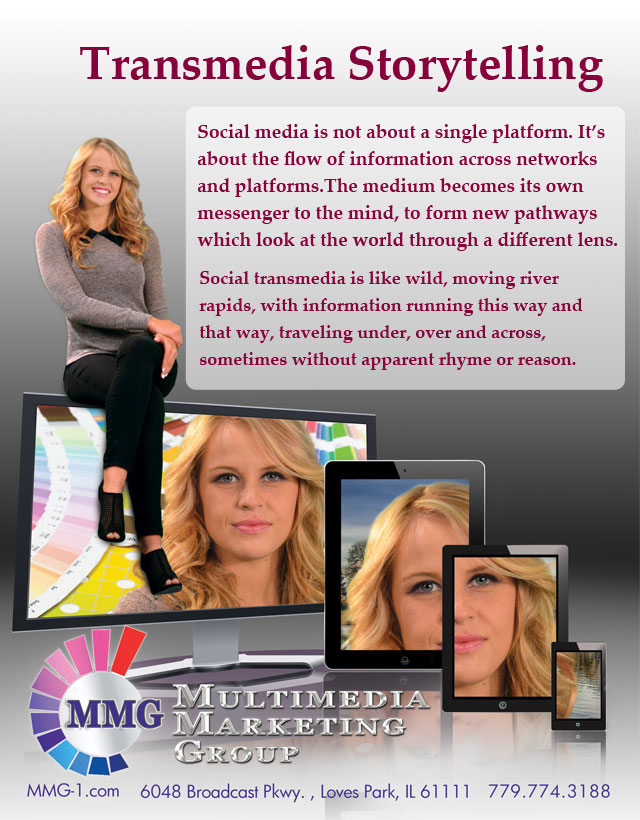
The Medium and the Message in the Reflective Mind as Plasticity
Drawing on research from social psychology, persuasion, and decision making, the mind reforms itself into Neuroplasticity, also known as brain plasticity, which is an umbrella term that encompasses both synaptic plasticity and non-synaptic plasticity—it refers to changes in neural pathways and synapses due to changes in behavior, environment, neural processes, thinking, emotions, and links communication with decision making into cognitive perceptions.
We are considerably shaped by experience. So do we understand how social media such as Facebook and LinkedIn are changing your brand and us? For anyone, of any age, who navigates the virtual realm of the Internet, they are impacted with the explosion of social media, complete with immediate videos on demand, stimulating graphics, and propagated text, which makes for “one great blooming, buzzing confusion” which is best described by William James a nineteen century philosopher, author and psychologist.
Social media is not about a single platform. It’s about the flow of information across networks and platforms. It’s about creating an immersive story through transmedia storytelling. The medium becomes its own messenger to the mind, to form new pathways which look at the world through a different lens.
Social transmedia is like wild, moving river rapids, with information running this way and that way, traveling under, over and across, sometimes without apparent rhyme or reason. That fluidity and ambiguity is also its self-same power. Everything is connected in nonlinear ways. Twitter, Instagram, Facebook, web pages, Snap Chat, YouTube, Pinterest, Flickr—you name it. For skilled transmedia marketers, these platforms allow the creation of a media-rich, immersive environment where, little by little—step by step, over these informational rapids—you become immersed in the compelling story.

There is continuing debate across the disciplines of psychology, sociology, and philosophy about the effects of Internet use on people’s cognitive faculties and interpersonal skills. Are our interpersonal and cultural skills being lost or indeed modified as users of this medium? Are we raising a new social culture of “crowd swarming” across the internet, in a way the world has never seen or is prepared for?
Human-computer interactions serve as an illuminating classic example of brain plasticity in the twenty-first century. Our real-time interactions online are changing our brains and are being shaped and conditioned by the images we see, the text we read, and the videos we watch. Our brain’s plasticity in cyberspace can aid us, taking advantage of our minds’ social and creative capacities.
- Engaging with social media makes your brand seem accessible, alive and responsive.
- Seeing interactive dialogue on social media, even with others, increases perceptual sense of intimacy because social media storytelling is immediate, direct and unfiltered.
- Feeling a part of the conversation increases our emotional belief that we know a brand because our instinctive brain doesn’t make the distinction between virtual and real that our logical brain does.
- By making demands on us, social media interaction turns us into stakeholders by placing demands on our emotional senses and attention.
- You can feel the pulse of the exchange in your mind, the excitement of followers and the energy level of the discourse making this a compelling and absorbing extension of self, and as a medium of communication, it demands participation.
- The medium becomes a compelling and absorbing extension of self (as in the example of Pinterest’s “My Style”), becoming ubiquitous, with self.
There are no definitive concrete answers to these and many other questions, but becoming more mindful about how our brains are changed by our experiences online will deepen your understanding of how transmedia storytelling works with the new 21st century mind. Cyberspace has altered human physiology. It makes us feel differently, think differently, as well dream differently. The internet and its launch pad technology, affects attention spans, our memory, and sleep cycles. For example neuroscientists’ state that the glowing lights emitted by laptop, tablet and smartphone screens jumble the body’s internal light cues and sleep-inducing hormones. Social media and the Internet have also been shown to shorten our attention spans. Individuals immersed in digital media find it difficult to read books for long periods of time, and often skim articles online rather than reading every word.*
“But even as some parents and educators express unease about students’ digital diets, they are intensifying efforts to use technology in the classroom, seeing it as a way to connect with students and give them essential skills. Across the country, schools are equipping themselves with computers, Internet access and mobile devices so they can teach on the students’ technological territory,” said Michael Rich, an associate professor at Harvard Medical School and executive director of the Center on Media and Child Health in Boston. Today we know that the brain is remarkably plastic. It can be maintained and improved in middle and old age and can continue to adapt and learn throughout life.
The concept of neuroplasticity is now a new, substantial marketing tool to understand ourselves and at the same time reveal a new positive insight about learning and transcending new ways to engage with your audience through transmedia storytelling.
Paul Arden, former creative director of Saatchi & Saatchi, sums this up nicely by explaining that typically when we say we “want” something, we actually just mean we want to have it, but with no implicit assumption that we have the understanding to get there.
The Case for Transmedia Storytelling Content
Video takes viewers through an experience that evolves over time, grabbing their attention and triggering a sequence of perceptual, cognitive, and emotional processes. Throughout the years, filmmakers have developed an arsenal of cinematic devices (e.g., montage, continuity, editing and close-up) to direct viewers’ minds during viewing. These techniques, which constitute the formal structure and aesthetics of any given cinematic text, determine how viewers respond to the video. The idea that stories can have a tight grip on viewers’ minds has been acknowledged since the early days of cinema,** but the extent that the stories inter-subject correlates in brain activity depends on the success of the filmmaker in controlling what viewers are looking at and being attentive to. A highly emotional video is likely to engage the emotional systems of the brain, for example, while a highly contemplative video would engage regions of the prefrontal cortex. Even within the same video the processing of different scenes may rely on the operations of different brain regions.

Putting story at the heart of your marketing is your best shot at a happy ending. Here are twelve reasons why:
- Stories are welcome where ads are resisted
- Stories are shareable and shapeable
- Stories carve the quickest path to the heart and the mind
- Stories, when combined with transmedia content marketing, moves the brand needle, increasing awareness, changing perception, creating desire and driving to purchase
- Stories spread—carried along by audiences over cyber-space
- Stories need to be at the heart, not the tail, of your marketing plan
- Stories need to be surrounded and amplified in all communication channels
- Stories need to be social at the core
- Stories need to be authentic
- Stories create a brand narrative and need to serve the same role as the product it promotes
- Stories activate a part of the brain (neural coupling) that lets the viewer turn the stories into their own ideas and experiences
- Stories engage multiple areas of the brain, when well told, (this includes the frontal cortex, the sensory cortex and the motor cortex) and video stories are the only ones which are able to do this effectively and repeatedly

Conclusion
In this article we introduced a new marketing paradigm—inter-subject correlation of brain activity—for measuring the effect that films have on viewers’ minds. This paradigm paves the way to an innovative new approach we call transmedia storytelling.
One of the challenges in selecting new technologies for marketing is balancing current needs while anticipating how emerging trends will evolve in the digital social media age.
About us and this article
We have the understanding and the clarity to help you learn the mechanics of crafting a great hook and a great story for your company to be able to meander through those “wild rapids” to create a strategic plan specifically for you.
We are media marketing experts in transforming inanimate words on your website into motion, emotion, impressions, and effective communication through transmedia storytelling by integrating this into a compelling social media initiative for you. This is part of the magic of creative, illustrative videos.
We create stories which are powerful catalysts for your marketing challenges.

Why transmedia
With transmedia you change… your clients grow, helping them prepare themselves to answer the demand for digital, social, and new transmedia content, through your influence….. A new rich media strategy emerges. Direct mail, print, digital, integrated into branded storytelling, social media platforms will enhance your business through a new transmedia strategy.
Your clients are increasingly favoring rich media alternatives to printed materials, as online media grows. Transmedia is marketing that gives a new breath of life to your business brand as it spreads across multiple platforms.
*Growing Up Digital, Wired for Distraction
http://www.nytimes.com/2010/11/21/technology/21brain.html?ref=yourbrainoncomputers&_r=0
**Barbara Knappmeyer
research scientist at the Department of Psychology and Center for Neural Science at New York University
http://hlab.princeton.edu/Papers/Hasson_Neurocinematics_2008.pdf
***Brain Rules

Recent Comments